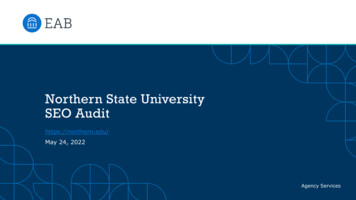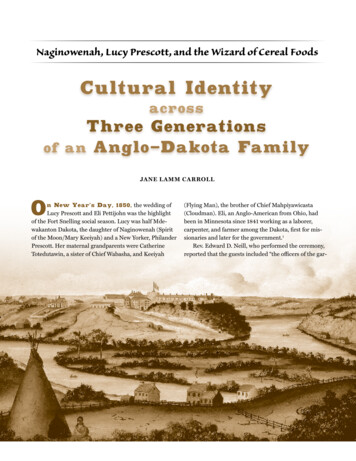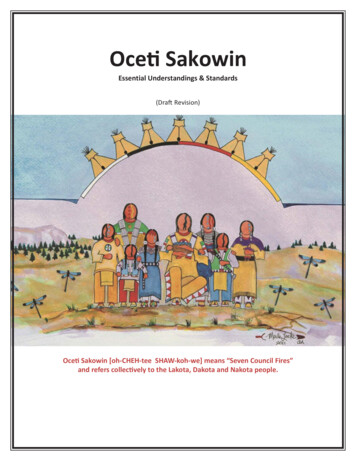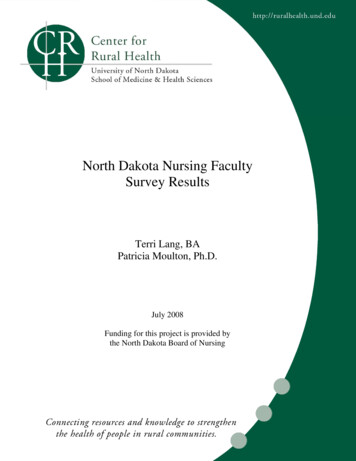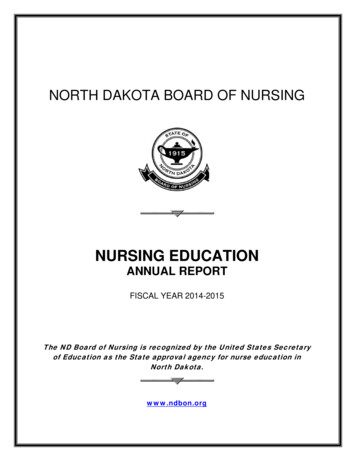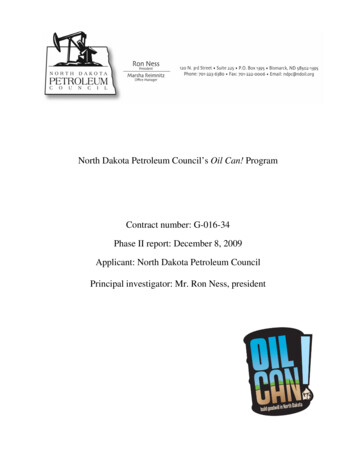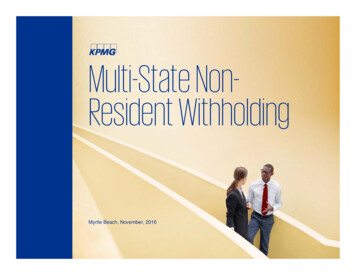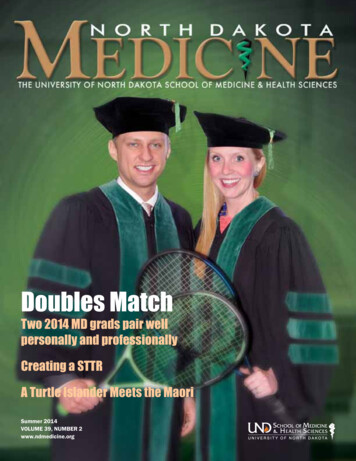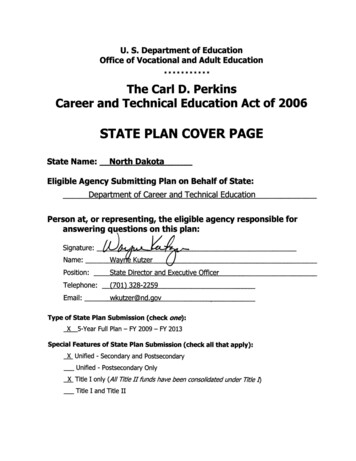
Transcription
NORTH DAKOTA STATE BOARDFORCAREER AND TECHNICAL EDUCATIONMr. Darrel Remington, Chairperson . BelfieldMr. Jeffery Lind, Vice Chairperson . RugbyMs. Maren Daley, Member . BismarckMr. Brian Duchscherer, Member .CarringtonMr. Robert Geske, Member . EnderlinMr. William Goetz, Member. BismarckMs. Susan Stibbe, Member. . HunterMs. Rita Wilhelmi, Member . StanleyDr. Wayne Sanstead, Member . Bismarck³It is the policy of the North Dakota State Board for Career and Technical Education not to discriminate in its educationalprograms, activities, or employment policies as required by Final Regulation implementing Title IX of the 1972 EducationAmendments, Title VI of the Civil Rights Act of 1964, Section 504 of the Rehabilitation Act of 1973.The Board policy does not advocate, permit, nor practice discrimination on the basis of sex, race, color, national origin,religion, age, or disability as required by various state and federal laws. Equal education opportunity is a priority of the1RUWK 'DNRWD 6WDWH %RDUG IRU &DUHHU DQG 7HFKQLFDO (GXFDWLRQ
Table of ContentsOVERVIEW .1I.PLANNING, COORDINATION, AND COLLABORATION PRIOR TO PLAN SUBMISSION .2II.PROGRAM ADMINISTRATION.7III. PROVISION OF SERVICES FOR SPECIAL POPULATIONS .49IV. ACCOUNTABILITY AND EVALUATION .57VI. FINANCIAL REQUIREMENTS .73VII. EDGAR CERTIFICATIONS AND OTHER ASSURANCES .82Page ii
OVERVIEWThe State Board for Career and Technical Education is responsible for administeringcareer and technical education in North Dakota as administered under Public Law 105 5HIHUHQFH WR WKH ³6WDWH %RDUG WKURXJKRXW WKLV SODQ UHIHUV WR WKLV RIILFLDO ERDUG The State Board consists of nine members, six of whom are appointed by the Governorfrom a list of persons submitted by a nominating committee. The other members areindividuals either elected or appointed to their positions as prescribed in State Law.They are the elected Superintendent of Public Instruction, the appointed Chancellor ofHigher Education and the appointed Executive Director of Job Service North Dakota.The State Board does not conduct career and technical education programs. It workswith public school districts, area career and technology centers, Bureau of Indian Affairsschools, tribally controlled colleges, state public colleges, state universities, and otherDJHQFLHV ZKR FRQGXFW FDUHHU DQG WHFKQLFDO HGXFDWLRQ SURJUDPV 7KH 6WDWH %RDUG¶V responsibilities to these various educational and other agencies include assistance inplanning, assisting curriculum development and implementation, and evaluating theirprograms.The State Board is responsible for the administration of federal and state legislation andthe supervision of funding made available from Congress and the state. Career andtechnical education is a program of instruction designed to prepare individuals withemployability skills in high quality programs requiring less than a baccalaureate degree.A sound career and technical program must be concerned with the employability ofstudents upon completion of the offering. But the program must also recognize theneeds of the individual for more than job-entry skills. Compatible skills of math, science,communication, decision-making, learning to learn, personal and occupationalresponsibility, educating students in all aspects of industry, and linking secondary andpostsecondary are equally important and equally within the purview of career andtechnical educatioQ 7KHVH ³WUXH VDODEOH VNLOOV DQG WKH LQGLYLGXDO¶V FDSDFLW\ WR WUDQVIHU them regularly and usefully to their work and life needs, require career and technicaleducation to emphasize the total education of the individual.The uniqueness of career and technical education, then, is in its capacity to not onlySUHSDUH IRU ZRUN EXW WR HQDEOH LQGLYLGXDOV WR GHYHORS WKH KXPDQ ³FKDQJH DQG FRSLQJ VNLOOV ZKLFK DUH HVVHQWLDO WR RFFXSDWLRQDO PRELOLW\ DQG SHUVRQDO VXFFHVV RYHU WKH ORQJ term of a working life.Page 1
I.PLANNING, COORDINATION, AND COLLABORATION PRIOR TO PLANSUBMISSIONA.1.Statutory RequirementsThe State Board for Career and Technical Education conducted hearings at thefollowing locations after filing the required notices as outlined in the North DakotaCentury Code. [Sec. 122(a)(3)]xxxxBismarck February 11, 2008Valley City February 12, 2008Devils Lake February 13, 2008Minot February 14, 2008The scheduled meeting in Devils Lake was canceled due to a winter storm.Because of the notice requirements, the meeting was not rescheduled.These four public hearings allowed all segments of the public and interestedorganizations and groups (including employers, labor organizations and parents)an opportunity to present their views and make recommendations regarding theState Plan. The public hearing notices were announced in the following manner:xPublic notices were placed in all 52 official county newspapers through thePublic Notice Coordinator of the North Dakota Newspaper Association.xLetters of invitation were sent to Department of Commerce, EducationalStandards and Practices Board, Department of Public Instruction, Job ServiceNorth Dakota, Chancellor of North Dakota University System, Department ofHuman Services, Greater North Dakota Chamber of Commerce, and NorthDakota AFL-CIO.x,QYLWDWLRQV XVLQJ HPDLO ³OLVWVHUYV ZHUH VHQW WR DOO VHFRQGDU\ VFKRRO administrators, community college administrators, secondary career andtechnical directors, college deans of career and technical education, secondarycareer and technical instructors, postsecondary career and technicalinstructors, and business and industry representatives.x³ IILGDYLWV RI 3XEOLFDWLRQV KDYH EHHQ UHFHLYHG IURP HDFK RI WKH PHGLD confirming dates of publications and are on file in the State Board office.Thirty people attended the three hearings held with members of the broadcast andprint press in attendance at the Minot public hearing.2. VXPPDU\ RI ZULWWHQ FRPPHQWV DQG WKH HOLJLEOH DJHQF\¶V UHVSRQVH WR VXFK recommendations in the State plan are. [Sec. 122(a)(3)]Page 2
The proposed State Plan was relatively well received and only the two commentslisted below were received during the comment period.Public Comment:Could the definition of concentrators and participants more clearly follow careerclusters path instead of enrollment in a particular program. Clearly a student goinginto the transportation industry will benefit, as would welding, automotive, etc?SBCTE Response:The definition contained in the final draft used for public comment is a modeldefinition developed through a national collaborative process facilitated by theOffice of Vocational and Adult Education with the intent that all states will reportmeasures approximating the same student population. This is to provideconsistency and to allow aggregation of the data to demonstrate the effectivenessof the Carl Perkins Act.The State Board recognizes that these model definitions for secondaryconcentrators and participants may be confusing since different states usedifferent credit measurements. To provide more clarity and not change themeaning or intent of the model definition, a modified definition will be proposed tothe Office of Vocational and Adult Education to reflect the way credits are awardedin North Dakota. :KHUH 1RUWK 'DNRWD¶V VHFRQGDU\ FUHGLW V\VWHP LV EDVHG RQ awarding of full annual credits, and not semester credits, the proposed definition isto designate two (2) credits to become a concentrator in a particular programarea.The two (2) credits in the modified definition should only constitute about one-halfRI WKH FDUHHU DQG WHFKQLFDO FUHGLWV LQ D VWXGHQW¶V SODQ RI VWXG\ 5HDFKLQJ concentrator status is to identify the students where career and technicaleducation has had an opportunity to affect student outcomes. By completingcourses and credits in the remaining areas within a career cluster the student maycomplete a career pathway within a career cluster.Public Comment:Regarding the sample student plan of study and the requirement of one unit ofCTE for graduation, I believe your department was instrumental in requiring thisone unit for incoming freshman in the 24 credits to graduate. How can you help usgain an additional credit for CTE? I believe this extra credit will be required inmath or scLHQFH ,I ZH DV &7( GRQ¶W VWDUW WKH FDPSDLJQ WR JHW WKLV FUHGLW LQ DSSOLHG math and science in CTE programs enrollment in CTE classes may decline.Page 3
SBCTE Response:The State Board will continue to work with the legislative process to ensure thatcareer and technical interests are represented as the increased graduationrequirements are implemented. The State Board recognizes that there is thepotential for crowding out of CTE elective courses as graduation requirements areincreased.3.The State plan was developed in consultation with academic and career andtechnical education teachers, faculty, and administrators; career guidance andacademic counselors; eligible recipients; charter school authorizers and organizersconsistent with State law; parents and students; institutions of higher education;the State tech prep coordinator and representatives of tech prep consortia (ifapplicable); entities participating in activities described in section 111 of Public Law105-220; interested community members (including parents and communityorganizations); representatives of special populations; representatives of businessand industry (including representatives of small business); and representatives oflabor organizations in the State. The Governor of the State was consulted withrespect to development of the State plan. [Sec. 122(b)(1)(A)-(B)]4.The State Board developed effective activities and procedures, including access toinformation needed to use such procedures, to allow the individuals and entitieslisted in item 3 above to participate in State and local decisions that relate todevelopment of the State plan. [Sec. 122(b)(2)]xAt the annual Professional Development Conference held August 6-8, 2007input was sought and provided from the various constituents above inattendance. Numerous workshops were presented by state staff, and otherpresenters. A featured workshop included a national expert on thedevelopment of Career Clusters and how the clusters relate to programs ofstudy. All program staff sought input from participants in the program areameetings held on both Monday and Wednesday.xState staff made a presentation to the members of the South Central EducationCooperative Regional Education Association an educational service agency onOctober 10, 2007 at Valley City State University for purposes of soliciting inputon the State Plan from school administrators and school board members.xState staff made a similar presentation to a district wide advisory committeemeeting in Grand Forks on October 23, 2007 to explain aspects of the plan andsolicit input.x7KH *RYHUQRU¶V :RUNIRUFH 6XPPLW ZDV KHOG October 11-12, 2007 bringingtogether education, government, and business and industry to addressPage 4
numerous issues regarding having a trained workforce. Career and TechnicalEducation was a sponsor of the event and an active participant. State staffattended the event and the State Director held session on Career and Technical(GXFDWLRQ¶V YLWDO UROH LQ SURYLGLQJ DSSURSULDWH HGXFDWLRQ DQG WUDLQLQJ WR PHHW current and future workforce needs at the same time identifying the needs ofbusiness and industry affecting how items were to be addressed in the StatePlan.xThe Director of CTE and state staff met quarterly with local directorsrepresenting secondary and postsecondary education explaining the componentparts of the State Plan, seeking input and making modifications. The meetingof November 10, 2007 included a session soliciting comment and input on thedraft State Plan.xThe State Director as a member of the Workforce Development Councilpresented information to the group and gave periodic updates relating to thedevelopment of the State Plan. The full plan was reviewed at the January 9,2008 meeting.xThe state supervisor for special populations solicited input into State Plandevelopment at their winter conference in January of 2008.xThe January, February, and March State Board meetings are all open to thepublic and opportunity to speak on the plan would be afforded to anyonewishing to address portions of the plan. After sufficient and proper notice, theState Board conducted three public hearings in the state, geographicallylocated to represent all area of the state.xEach local career and technical program has an advisory committee made up ofstudents, business and industry representatives, instructors and communitypeople to provide input into state and local plan and program development.x7KH 6WDWH %RDUG FRQVXOWHG ZLWK WKH *RYHUQRU¶V 2IILFH LQ WKH IROORZLQJ PDQQHUxxA copy of the transition plan was forwarded to his office. 7KH *RYHUQRU¶V Office was also provided with a copy of the final draft with a request tomake comments.The State Board for Career and Technical Education presented a draft of theplan to the Workforce Development Council for their comments, and has alsobeen actively involved with the committee currently working on the unifiedplan.Page 5
5.The State plan was developed relating to the amount and uses of any fundsproposed to be reserved for adult career and technical education, postsecondarycareer and technical education, tech prep education, and secondary career andtechnical education after consultation with the State agency responsible forsupervision of community colleges, technical institutes, or other 2-yearpostsecondary institutions primarily engaged in providing postsecondary careerand technical education, and the State agency responsible for secondaryeducation. If a State agency finds that a portion of the final State plan isobjectionable, the State agency must file its objections with you. You mustrespond to any objections you receive in the State plan that you submit to theSecretary. [Sec. 122(e)(3)]xThe Superintendent of Public Instruction (Chief State School Officer) is a votingmember of the State Board for Career and Technical Education and attends allmeetings.xThe Chancellor of Higher Education is a voting member of the State Board forCareer and Technical Education and attends all meetings.xThe State Director met periodically with each individual to keep them informedon the progress of the State Plan.Comments from Superintendent of Public Instruction and from the Chancellor ofHigher Education:SBVTE Response:Because both serve on the State Board for Career and Technical Education, theircomments were included, with their input, at the State Board meeting.Page 6
II.PROGRAM ADMINISTRATIONA.Statutory Requirements1.The State Board for Career and Technical Education submits to the Secretary aState plan for a 5-year period July1, 2008 to June 30, 2013. [Sec. 122(a)(1)]2.The State Board will address the following activities to assist in meeting orexceeding the state adjusted levels of performance.(a) The State Board for Career and Technical Education will develop programs ofstudy, that may be adopted by local educational agencies and postsecondaryinstitutions to be offered as an option to students (and their parents asappropriate) when planning for and completing future coursework, for careerand technical content areas that²To encourage collaboration between secondary and postsecondaryinstitutions locally modified programs of study will be submitted for reviewand must include the following elements:i. Incorporate secondary education and postsecondary education elements;using the Career Clusters model to develop these programs of study.Career Clusters Prepare All Students for College and CareersxTo prepare today¶s students for tomorrow, schools are working tohelp students achieve in challenging subjects. One key approach tothis goal is to provide students with relevant contexts for learning.Career clusters link what students learn in school with the knowledgeand skills they need for success in college and careers. Careerclusters help students identify pathways from secondary schools topostsecondary credentials, certificates, diplomas, or degrees, as wellas to the workplace. Career pathways help students identify theconnection between rigorous courses and their future goals.xNDCTE has adopted the career clusters model of 16 career clustersincluding plans of study with pathways to be implemented. The Stateprograms of study will be modeled after the national templates foundat www.careerclusters.org supported through the College to CareerTransition Initiative (CCTI). Formal programs of study documentswithin the 16 career clusters have been developed by a planningteam at the state supervisor level that were introduced statewide atthe Professional development conference in August 2007.Page 7
xGuidelines and criteria for programs of study will be established andState staff will provide the technical assistance necessary to facilitatethe development of programs of study to ensure each programcontains coherent and rigorous career and technical educationcurriculum content including challenging academic and relevanttechnical standards; aligns secondary and postsecondary career andtechnical education in a non-duplicative progression of courses;provides opportunities for secondary students to earn postsecondarycredit, where applicable; and leads to an industry-recognizedcredential, postsecondary certificate or associate degree, and alsoinclude potential baccalaureate degrees and identify transferabilitywhere applicable.Following is a sample template:Page 8
English IEnglish IIEnglish IIIEnglish IVPathwayBusiness Administration & ManagementEntrepreneurshipInternational BusinessMarketing ManagementHuman Resources Development/Mgmt.Business & Administration Management PhysicalEducationHealth Business Administration & ManagementEntrepreneurshipFacility ManagementMarketing ManagementInternational BusinessHuman Resources Development/Mgmt.Business & Administration ManagementFacility Management Masters Degree or MoreSchool-Based: FBLA DECA Career Research Cooperative Education Internship Job Shadowing Service Learning ProjectCommunity-Based: Mentorship Volunteer Part-time EmploymentAdditional SuggestedLearning OpportunitiesPage 9Business Administration & ManagementBusiness Administration & ManagementMarketing ManagementIntroduction to BusinessConsumer EducationAccountingWord ProcessingSpreadsheet ApplicationsDatabase ApplicationsElectronic PresentationsDesktop PublishingWeb DesignBusiness Technology ProceduresBusiness LawBusiness CommunicationsBusiness MathNorth Dakota Career & Technical Educationand Other Electives(one unit of foreign or Native American language,fine arts, or career and technical education requiredto graduate)It is suggested that students consider appropriate dual credit, articulation, or advanced placement opportunities for postsecondary credit.2007 DRAFT-ND Department of Career and Technical EducationOPERATIONS MANAGEMENTHUMAN RESOURCES MANAGEMENTCORPORATE/GENERALMANAGEMENTBUSINESS INFORMATIONTECHNOLOGY Physical Education(one unit requiredto graduate)SAMPLE NORTH DAKOTA POSTSECONDARY PROGRAMS RELATED TO THIS CAREER CLUSTERAssociate Degree or LessBachelors Degree Office Supervision & ManagementAdministrative Assistant (general/legal/medical)Computerized Office ManagementInformation Processing TechnicianOffice Supervision & ManagementReception ServicesManagement Information Systems Management Information Systems World HistoryU.S. HistoryGovernmentEconomics PhysicalScienceBiology Algebra IGeometryAlgebra IISocial Studies(three units requiredto graduate)Science(two units requiredto graduate)Math(two units requiredto graduate)ADMINISTRATIVE SERVICES English(four units requiredto graduate)SAMPLE OCCUPATIONS RELATING TO THIS CAREER CLUSTEROccupationsExecutive Assistant x Administrative Assistant x Office Manager x Project Coordinator x Customer Service RepresentativeProject Manager x Business Analyst x Process Manager x Functional Specialist x Process ArchitectSupervisor x Store Manager x District Manager x Director x EntrepreneurHuman Resource Manager x Compensation Analyst x Labor Relations Specialist x Training Manager x RecruiterPurchasing Manager x Master Scheduler x Procurement Analyst x Quality Manager x Supply Chain ManagerNameSchoolDateSUGGESTED COURSE OF HIGH SCHOOL STUDYIt is suggested that students consider appropriate dual credit, articulation, or advanced placement opportunities for postsecondary credit.PathwayADMINISTRATIVE SERVICESBUSINESS INFORMATION TECHNOLOGYCORPORATE/GENERAL MANAGEMENTHUMAN RESOURCES MANAGEMENTOPERATIONS MANAGEMENTMANAGEMENT AND ADMINISTRATIONSample North Dakota Career Cluster Plan of Studywww.nd.gov/cte x www.careerclusters.org
ii. These programs of study will include coherent and rigorous content,aligned with challenging academic standards, and relevant career andtechnical content in a coordinated, non-duplicative progression of coursesthat align secondary education with postsecondary education toadequately prepare students to succeed in postsecondary education:xIn addition to the Career Clusters, model programs of study will bebased on industry standards and each program will be based oncurriculum standards that address academic and technicalachievement in a coordinated and non-duplicative manner.xWhy Standards ExistThe North Dakota Department for Career and Technical Education iscommitted to developing standards to ensure each program areaoffers courses that allow students to acquire essential knowledge andskills.xWhat Standards AreStandards identify what students are expected to know and be ableto do²the content they are expected to acquire, the skills they areexpected to attain, and the intellectual qualities and habits of mindthey are expected to develop. With the standards in place, schoolscan create, implement, and strengthen a Career and TechnicalEducation (CTE) curriculum to prepare students for entry intoindustry sectors and for postsecondary education.xHow Standards Are CreatedThe standards process begins with a review of national and industrystandards. The state CTE program area supervisor(s), secondaryteachers, counselors, postsecondary teachers, business and industryrepresentatives, and the Research & Curriculum Administrator forCTE, work together to write the standards. The standards are writtento ensure that when the students complete their courses they havethe knowledge and skills needed in business and industry.xHow State Academic Standards Are IntegratedThe final step of the standards writing process involves³crosswalking the standards with academic areas such asEnglish/Language Arts, Mathematics, Science, Social Studies, andLibrary/Technology Literacy. Crosswalks provide CTE teachers theresources necessary to integrate related state academic standardsinto the CTE curriculum. The most current drafts of the stateacademic documents, produced by the North Dakota Department ofPublic Instruction, are used in the cross walking process. These statestandards are available m.Page 10
iii. Programs of study will include the opportunity for secondary educationstudents to participate in dual or concurrent enrollment programs or otherways to acquire postsecondary education credits;The dual credit program signed into law by the 1997 North DakotaLegislature allows high school juniors and seniors who want to earncollege courses to benefit from this program.Students have always been able to take college courses for credit - asadditions to their high school workload. With the dual credit plan, thecollege class is a replacement rather than an addition. Students take justone class - the college class - and get both high school and college creditfor it.The agencies involved in this unique cooperative relationship: the N.D.Department of Career and Technical Education, N.D. Department of PublicInstruction, N.D. University System.iv. Programs of study will lead to an industry-recognized credential orcertificate at the postsecondary level, or an associate or baccalaureatedegree;The agency will use the Career Clusters model previously described. Theplans of study are designed to be academically rigorous whileincorporating the necessary technical proficiencies. The curriculum isbased on industry standards through the curriculum development andstandards processes. Certification is accomplished through CompTIA,Cisco, ASE, NCCER, CNA, among others. Some certifications can beaccomplished without postsecondary education while others requireadditional levels of education, but each of the pathways is designed tolead to all levels of education.In addition, The State Board will assist Local Education Agencies (LEA) toensure access to a full range of career and technical education programs forall students. Activities will be developed and/or conducted in support ofachievement of each of the core indicators of performance by each of theLEAs. The core indicators are as follows:xattainment of challenging academic, career and technical standards,xattainment of a secondary diploma or equivalency, skill certificate, orpostsecondary degree or credential,Page 11
xplacement in further education or training, employment, or militaryservice,xcompletion of programs for nontraditional training and employment.Quality career and technical education programs are provided for students atthe secondary, postsecondary and adult level. These programs are inAgriculture, Business and Office Technology, Career Development (Guidance),Educational Equity, Family and Consumer Sciences, Information Technology,Marketing Education, Curriculum and Personnel Development, Special Needs,Technology Education, and Trade, Technical and Health Education.xData Collection the redesign of the data collection system will assurethat valid and reliable data are collected. The data will be used to assist inmeeting the adjusted levels of performance.xEvaluation Instrument the self-study and evaluation process arereviewed and revised annually to assure that the evaluation systemaccurately reflects the quality of the career and technical educationprograms.xLocal Education Plan the redesign of the Local Education Plan will focuson the desired outcomes.xConsortium Approval Process the consortium approval process will focuson all members of the consortium meeting the state adjusted levels ofperformance.xTechnical Assistance the State Board will review the technical assistanceprocess to ensure that these services are of the highest quality.(b) The State Board, in consultation with eligible recipients, will develop andimplement the career and technical programs of study described in (a) above;Model programs of study will be proposed by program supervisors. Programsof study will use Career Clusters, Pathways, and Plans of Study. Statewidemeetings involving select secondary and postsecondary instructors will beused to obtain input and modifications to the programs of study. Theresulting plans will be presented to teachers at statewide forums before finalapproval is given by the State Board.(c)The State Board will support eligible recipients in developing andimplementing articulation agreements between secondary education andpostsecondary education institutions;Page 12
The goal for articulation agreements is that they be statewide agreements.Program supervisors will provide technical assistance with the potential forgrant monies to local eligible recipients. The North Dakota University Systemhas in existence an office of articulation that will be used to help coordinatethese agreements at the postsecondary level.(d) Information about career and technical programs of study offered by eligiblerecipients at the secondary level will be made available through severalmeans;Provide a coordinated occupational and career information delivery system inNorth Dakota including:xCareer planning;xCareer development program implementation;xTraining and education program planning.The Career Development program supervisor, local career developmentcounselors, and the North Dakota Career Resource Network (NDCRN) arepartners in this activity.xSupport career guidance and academic counseling programs designed topromote improved career and education decision making by individuals(especially in areas of career information, delivery, and use).xMake available to students, parents, teachers, administrators, andcounselors.xEquip teachers, administrators, and counselors with the knowledge andskills needed to assist students and parents with career exploration,educational opportunities, and education financing.xAssist appropriate State entities in tailoring career-related educationalresources and training to their specific needs.xImprove coordination and communication among administrators andplanners of programs authorized by this Act.xProvide ongoing means
The State Board for Career and Technical Education is responsible for administering career and technical education in North Dakota as administered under Public Law 105- 5HIHUHQFH WR WKH ³6WDWH %RDUG WKURXJKRXW WKLV SODQ UHIHUV WR WKLV RIILFLDO ERDUG The State Board consists of nine members, six of whom are appointed by the Governor

